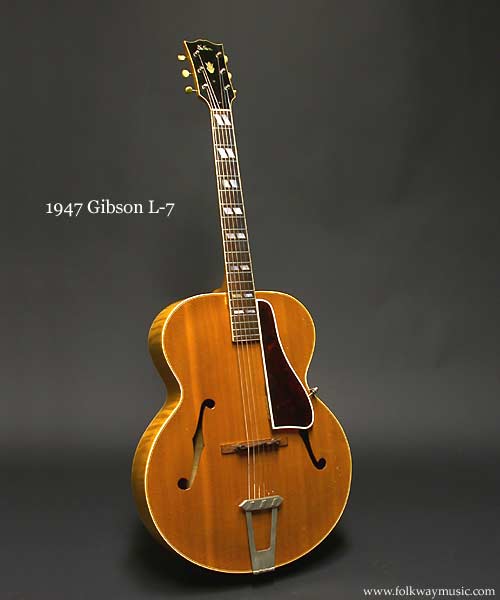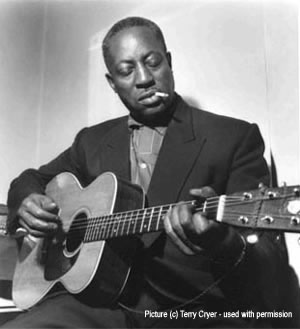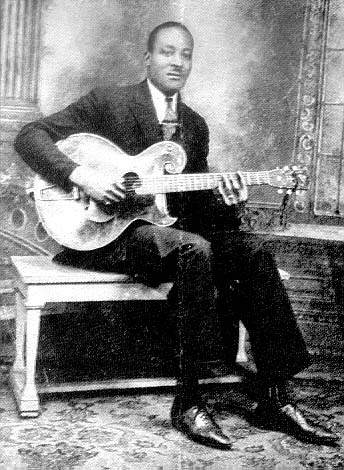

| Possible birth of William Lee Conley Broonzy, June 26 in Scott, Mississippi. See bio | The Broonzy family leaves Mississippi for Pine Bluff, Arkansas. | Big Bill manufactures a violin with parts of a cigar box, and a guitar with his friend Louis Carter. | William and Louis start to appear fish fries and local festivals. | William Broonzy joins the US Army. | Continuing to work as an amateur violinist, Bill took up various odd jobs. In this year Big Bill Broonzy left Arkansas for Chicago. |
| Bill learns how to play of the guitar, by listening to and watching other Chicago bluesmen. He is taught some stuff by Papa Charley Jackson | Big Bill Broonzy records his first titles with John Thomas (Tomps) on second guitar.House Rent Stomp, Big Bill Blues, Gonna Tear It Downand Tod Pail Blue, Dying Day Blues which will not be released by Paramount. | In November Big Bill returns to the studio and cuts House Rent Stomp, which this time will be put on sale. | New sessions in the studio, as a leader of The Famous Hokum Boys which include , Georgia Tom and Frank Brasswell. | Big Bill appears in many Chicago clubs | Records for Bluebird the label belonging to Victor Melrose as well as for Okeh, and Vocalion, Big Bill records some of his more beautiful titles. In November, he cuts She Caught the Train, The Dozens, Don' t Tear my Clothes and Ash Hauler, Jazz Gillum is present at the sessions |
| Big Bill Broonzy takes part in the first Carnegie Hall concert:From Spirituals to Swingbringing his music to a wider American public. | Big Bill records new masterpieces: Make my Get Away, Looking for My Baby, My Mellow Man, Knockin' Myself Out, Wee Wee Blues. Including sessions in which he accompanied others he was in the studio for 41 sessions. | Big Bill Broonzy continues his career in Europe. Helped by Hugues Panassié, he takes the blues to France. Recordings - Including Black, Brown & White - for Vogue. | On return to Chicago, he records forChess Records, the most famous label in Post War Chicago Blues. | Big Bill performs in Parisian clubs. | August 15, 1958, Big Bill Broonzy dies in Chicago from complications with cancer. Many blues men including Muddy Waters attend his funeral |
his is an image of Bill as a young man. The guitar he is holding is a Gibson Style O Go here to find out more
ther sites with stuff about BBB are
ere (General)
ere (a pictorial discography)
ere (Wikipedia)
ere (the Starkville School, MS, project)
Big Bill Blues (1955)
(~184 pg)Read Online
(11 MB)PDF
(~184 pg)EPUB (beta)
(~184 pg)Kindle (beta)
(~184 pg)Daisy (beta)
(268 KB)Full Text
(9.95 MB)DjVu
Publisher: Oak Publications
Language: English
Call number: 2599
Book contributor: Universal Digital Library
Collection: universallibrary
A Conversation with Studs Terkel (June 4, 2004)
![[item image] [item image]](http://ia331319.us.archive.org/3/items/pu_studsterkel/studs_terkel_0604.gif?cnt=0)
Video Files
Other Files
A Biography~
espite years of research, the details of William Lee Conley Broonzy's birth date remain problematic. He may have been born on 26 June 1893 - the date of birth he often gave - or according to Bill's twin sister Laney, it may have been in 1898. Laney claimed to have  documents to prove that. However recent research using the 1930 census suggests that he was actually born in 1901 (see below). The place of his birth was probably Scott, Mississippi, but .......
documents to prove that. However recent research using the 1930 census suggests that he was actually born in 1901 (see below). The place of his birth was probably Scott, Mississippi, but .......
ill's father Frank Broonzy and his mother, Mittie Belcher had both been born into slavery and Bill was one of seventeen children. His first instrument was a violin which he learned to play with some tuition from his uncle, his mother's brother, Jerry Belcher.
he family moved from Mississippi to Pine Bluff, Arkansas where young Bill worked as a violinist in local churches at the same time as working as a farm hand. He also worked as a country fiddler and local parties and picnics around Scott Mississippi. Between 1912 and 1917, Bill worked as an itinerant preacher in and around Pine Bluff. From 1918 to 1919 Broonzy served in the US army.
ater, returning to Arkansas, he worked in clubs around Little Rock. In about 1924, Big Bill moved to Chicago Illinois, where as a fiddle player he played occasional gigs with Papa Charlie Jackson. During this time he learned to play guitar and subsequently accompanied many blues singers, both in live performance and on record. Bill made his first recordings in 1927 and the 1930 census records him as living in Chicago and (working as a labourer in a foundry) and his name was recorded as 'Willie Lee Broonsey' aged 28. He was living with his wife Annie (25) and his son Ellis (6).
ig Bill became an accomplished performer in his own right, and, on 23 December, 1938, was one of the principal solo performers in the first "From Spirituals to Swing" concert held at the Carnegie Hall in New York City. In the programme for that performance, Broonzy was identified in the programme only as "Big Bill" (he did not become known as Big Bill Broonzy until much later in his career) and as Willie Broonzy. He was described as:
he best-selling blues singer on Vocalion's 'race' records, which is the musical trade designation for American Negro music that is so good that only the Negro people can be expected to buy it."
he programme recorded that the Carnegie Hall concert "will be his first appearance before a white audience".
ig Bill was a stand-in for Robert Johnson, who had been murdered in Mississippi in August that year. Hammond heard about Johnson's death just a week before the concert was due to take place. According to John Sebastian (1939) Big Bill bought a new pair of shoes and travelled to New York by bus for the concert. Where he travelled from is, however, left dangling. The inference of the text is that it was from Arkansas, but by by late 1938 Bill was established as a session man and as a solo performer in Chicago and within weeks of the 1938 concert Bill was recording with small groups in a studio in the windy city.
n the 1938 programme, Big Bill performed (accompanied by boogie pianist Albert Ammons) "It Was Just a Dream" which had the audience rocking with laughter at the lines,
reamed I was in the White House, sittin' in the president's chair.
I dreamed he's shaking my hand, said "Bill, I'm glad you're here".
But that was just a dream. What a dream I had on my mind.
And when I woke up, not a chair could I find"
ccording to Harry "Sweets" Edison, a Trumpeter with the Count Basie Orchestra, also in the concert, Big Bill was so overwhelmed by the audience response that he failed to move back stage as the curtain came down and got caught in front of it. Later, according to Edison) perhaps not realising he had to do a number in the second half of the concert,he was found to have left the Carnegie Hall and caught a bus home.
egardless of the truth of that story, when a second concert was organised in 1939, on Christmas Eve, Bill was there again. This time, again with Albert Ammons, he performed two numbers: Done Got Wise, and Louise, Louise
he guitar on the left is a Martin model 00028, a beautiful instrument. Bill played one of these from the 1950s to his death on 15th August 1958.
http://blues.about.com/od/artistprofil2/p/Broonzyprof.htm
Big Bill Broonzy Profile
By Reverend Keith A. Gordon, About.com Guide
Big Bill Broonzy's The Young Big Bill Broonzy
Photo courtesy Price GrabberBig Bill Broonzy Profile:
Born: June 26, 1893 in Scott MS
Died: August 15, 1958 in Chicago IL
Perhaps more than any other artist, Big Bill Broonzy brought the blues to Chicago and helped define the city’s early sound. Born, literally, on the banks of the Mississippi River, Broonzy moved with his parents to Chicago as a teenager in 1920, picking up the guitar and learning to play from older bluesmen like Papa Charlie Jackson. Broonzy began recording in the mid-1920s and by the early-1930s he was a commanding figure on theChicago blues scene.
The Early Chicago Sound
Capable of playing in both the older vaudeville styles (ragtime and hokum) and the newly-developing, more sophisticated Chicago style, Broonzy was a smooth vocalist, accomplished guitarist, and prolific songwriter. With its roots in the past, but looking towards the future, his music appealed to the growing numbers of African-American immigrants coming to Chicago from the south.
Broonzy began recording for Paramount in 1927, but it is was work for Bluebird Records during the 1930s, including playing behind talents like Tampa Red, Washboard Sam and John Lee "Sonny Boy" Williamson, that helped define the popular sound that was known as "The Bluebird Beat." In 1938, Broonzy performed at John Hammond's "Spirituals To Swing" concert as a last-minute replacement for Robert Johnson. The appearance opened his music up to an entirely new audience, winning him a small role in the film Swingin' The Dream alongside Benny Goodman and Louis Armstrong.
The Real Folk Blues
"Big Bill" earned a reputation as a mentor to young blues artists just arriving in Chicago, helping them find jobs and housing. Muddy Waters was one such beneficiary of Broonzy's largesse, and he recorded an album of Broonzy's songs in 1960 in tribute to his friend.
When the post-war blues boom rendered Broonzy’s quaint homegrown style a thing of the past, he re-invented himself as a singer of authentic folk-blues and became one of the first blues artists to tour Europe, developing a new and appreciate following. Broonzy's biography, Big Bill Blues, was published in 1955, as told to Danish writer Yannick Bruynoghe.
Recommended Albums: The best of Broonzy’s early work can be found on The Young Big Bill Broonzy, but you can’t go wrong with just about any of the many collections of Broonzy’s music.








![[item image] [item image]](http://ia311519.us.archive.org/3/items/bigbillblues002599mbp/bigbillblues002599mbp.gif?cnt=0)
![[item image] [item image]](http://ia351426.us.archive.org/3/items/opensource_audio/opensource_audio-header.gif?cnt=0)
![[help] [help]](http://www.archive.org/images/question.gif)
![[Public Domain] [Public Domain]](http://creativecommons.org/images/public/norights.gif)

Nincsenek megjegyzések:
Megjegyzés küldése